Under natural conditions, aglaonema lives in tropical and subtropical forests. Evergreen herbs and subshrubs of this genus are related to Dieffenbachia, so they are similar in shape and color of leaves, the only difference is in size.
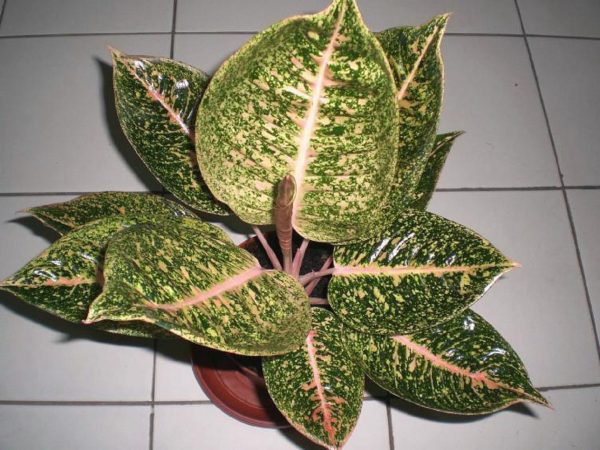
This is what an indoor aglaonema flower looks like
The plant is low, 50-60 cm, some species grow up to 1.2 m. 5-6 leaves appear per year. The trunk of Aglaonema is fleshy, short and straight. Many varieties and forms have a trunk branching at the base. In young plants the stem is not noticeable, but in adults it has traces of petioles from previously growing leaves.
Describing this indoor plant, one cannot fail to mention that the main advantage of the flower is its bright foliage, combining all shades of green and red, as well as easy care of aglaonema at home.
The shape of the leaves is varied, varying from oblong lanceolate to wide oval. Characterized by a depressed middle vein. The color of the leaves, depending on the variety, can be uniformly colored, edged or variegated. This is clearly visible in the photographs.
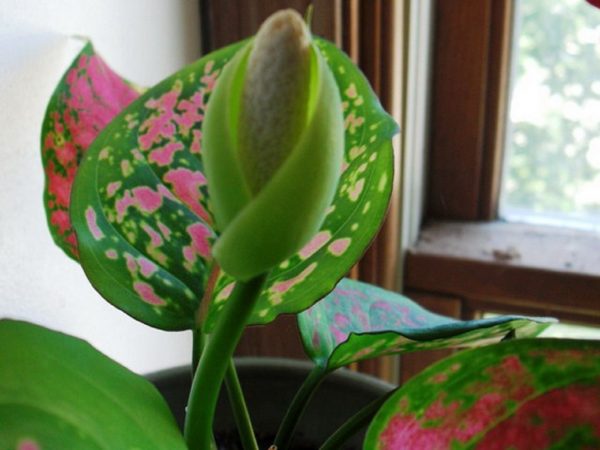
The photo clearly shows this inflorescence in the form of a cob.
In the axils of the leaves, 1-3 inflorescences are formed in the form of a cob, wrapped in a pale light green shell. The appearance of the cob depends on the variety and can be thin cylindrical or thick and club-shaped. The result of aglaonema flowering is a fruit-berry of scarlet, orange or white color, which contains one seed that takes 6-8 months to ripen.
What to do after purchasing a plant
After purchasing aglaonema, you need to perform several steps:
- give 2-3 weeks to adapt to the new environment;
- carry out disease and pest prevention;
- After 2-3 weeks, carefully transfer the flower into a new pot.
Important! The size of the new pot should not exceed the size of the root system.
When replanting, carefully check the presence of a plastic seedling pot among the roots. If found, it should be removed.If this is not done, then over time the plastic can damage the roots, which will cause them to rot.
How to care for aglaonema at home
When growing a home flower, you must take into account that in nature, aglaonema lives in the tropics under the trees of humid forests. Hence the specific needs indoor flower in lighting, heat and air humidity.
Lighting
Aglaonema will be comfortable on eastern and western windows with moderate, indirect light.
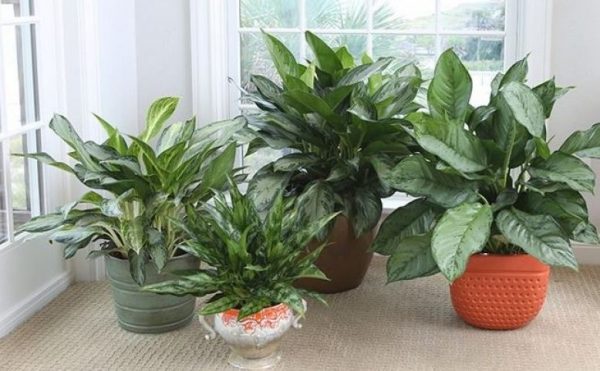
The plant will feel comfortable on western and eastern windows
Variegated forms require bright but diffuse lighting.
Watering
The watering regime when caring for aglaonema at home is of great importance. The soil must be kept constantly moist. Use warm water for watering soft water. After watering, the soil should be moderately moist.
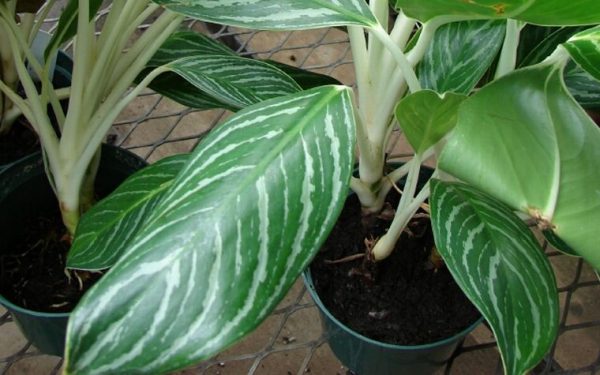
The soil in the pot should always be moist
In spring and summer, aglaonema is watered abundantly, after the top layer of soil has dried by 2-4 cm. In autumn and winter, the flower should be watered with caution, after about 2 days, also focusing primarily on the dryness of the soil.
Soil moisture can be checked using a wooden stick. It should be stuck into the ground to a depth of 5 cm, held for 15 minutes and pulled out. If the stick is dry at a depth of 2-4 cm, then it’s time to water the flower. Sticky particles of soil indicate soil moisture.
Important! Do not let the soil dry out completely. This leads to the death of the delicate absorptive hairs of the roots.
Feeding
During the active growing season (spring-summer season), aglaonema requires fertilizing in apartment conditions every 2 weeks with liquid universal fertilizer. Organic and mineral fertilizers are alternated, preparing them according to the instructions.
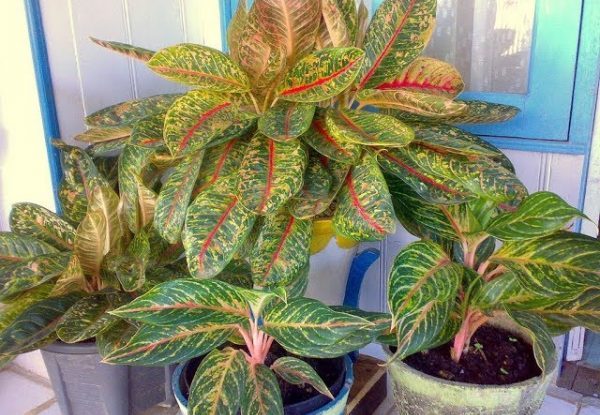
It is recommended to alternate root and foliar feedings
Foliar feeding 1-2 times a month is also necessary.
During the dormant period - autumn and winter - no feeding is required.
Temperature
In the summer season, a temperature range of +20°...+25°C will be comfortable for aglaonema. The home flower does not like sudden changes in temperature and drafts. For successful growth and development of colored species of aglaonema, a higher temperature is required - +24°...+26°C.
In winter, the ambient temperature should be reduced to +16°…+18°C.
Priming
For aglaonema, a light peat-based soil that is capable of permeating air and moisture is suitable:
- 2 parts of turf land;
- 2 parts of high peat;
- 1 part sand;
- 1 part humus.
Vermiculite, pieces of coal and pine bark are used to loosen the soil and can make up from 10 to 30% of the total volume of the substrate.
Humidity
Aglaonema requires moderate air humidity. Without sufficient moisture, plants do not develop, leaves do not unfold, become deformed, and their edges dry out. In summer you should spray the leaves with soft water at least 2-3 times a week, in the hot season - every day. To increase humidity, place the flower on a tray with expanded clay or pebbles, avoiding the bottom of the pot coming into contact with water.

When caring for aglaonema in an apartment, do not forget to spray it
During the winter-autumn season, spraying is carried out infrequently. You can bathe the flower under a warm shower. Such procedures with water help plants breathe and protect against pests.
Trimming
After 2-3 years of growth, the trunk becomes longer, the color of the leaves becomes less variegated. There comes a time when aglaonema needs to be renewed by planting an apical cutting.This procedure can be combined with the propagation of aglaonema by cuttings.
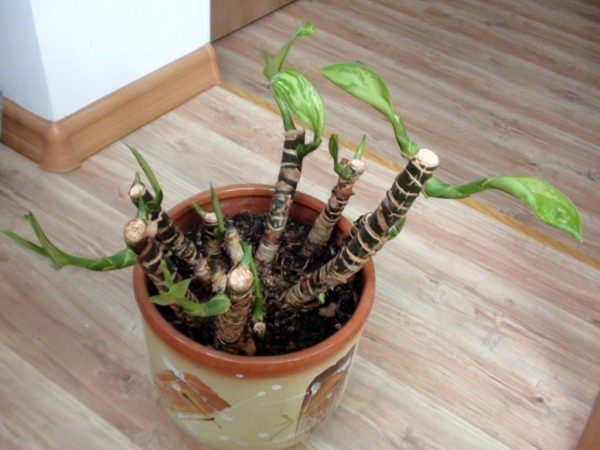
After pruning, new shoots began to appear
You should not get rid of the stump left after pruning; after a while, new shoots will emerge from the root.
Transfer
Young plants require replanting once a year. Adult aglaonema flowers are replanted once every 3-4 years. The plant transplantation procedure is better tolerated in the spring.
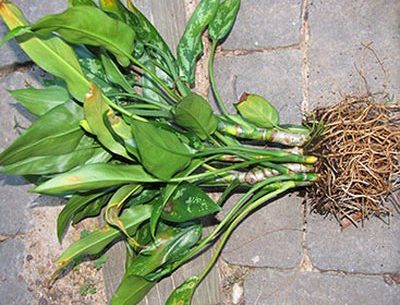
It's time to transplant the flower into a larger pot.
Do not forget about the size of the pot, which should always be proportionate to the volume of the roots. When planting in an overly large pot, the growth of green mass stops until the roots fill the entire earthen ball. In a large pot, there is a high probability of water stagnation, which means rotting of the roots.
Bloom
The onset of flowering indoors indicates good care and health of the plant. Flowering can occur between February and November. But in terms of decorative qualities, flowers are inferior to leaves. Moreover, it is recommended to remove all inflorescences so that the leaves do not weaken and become smaller.
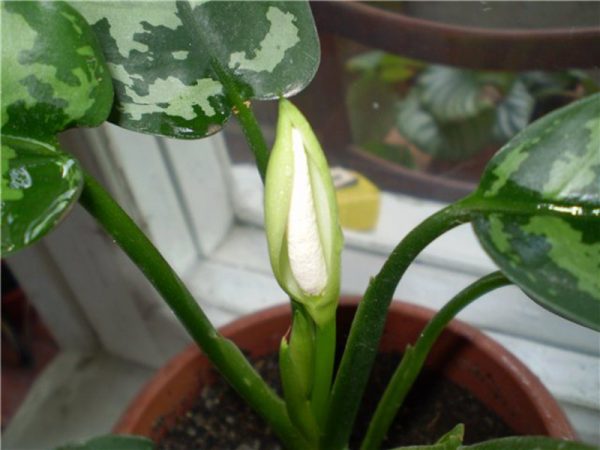
This is how aglaonema blooms
Flowers are saved if they want to get seeds. It is worth remembering that varietal characteristics using the seed propagation method are unstable.
Reproduction of aglaonema
The favorable time for the propagation of aglaonema is spring or summer. This is done using stem or apical cuttings, dividing roots, shoots, and seeds.
1. Growing from seeds
Aglaonema seeds ripen even at home, but quickly lose their viability. Therefore, it is better to sow them immediately after ripening.
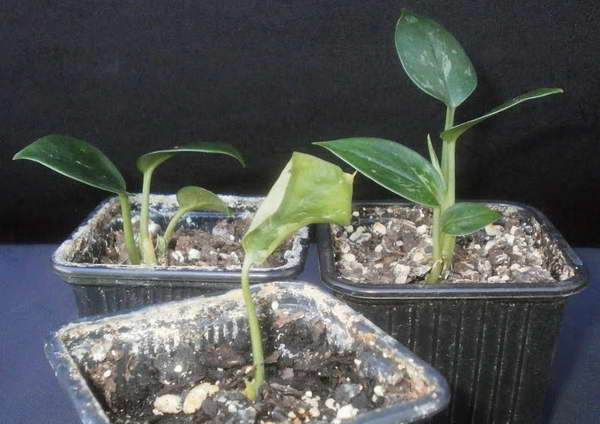
Aglaonema from seeds photo
The seeds are removed from the fruit, washed with water and immediately planted in moist sphagnum to a depth of 1–1.5 cm. The crops are provided with warmth and moisture.To do this, cover the container with film. Lowering the temperature reduces the germination rate. Fresh seeds under favorable conditions germinate in 18-26 days.
Seedlings emerge after the first few true leaves appear. When caring for seedlings, you need to remember that as they grow, they are replanted several times. Full-fledged plants are obtained after 3-4 years.
Growing aglaonema from seeds is a less productive method than propagation by cuttings or dividing roots.
2. Cuttings of Aglaonema
If the adult stem of the plant has stretched out and become bare, it’s time to cuttings:
- Select a stem and cut it at a level of 2-3 cm above the soil surface.
- Divide the shoot into several parts containing two nodes. All foliage must be removed, leaving a minimum number of leaves at the top.
- Sprinkle cuttings with charcoal powder and dry them for 24 hours.
- Pour drainage into the bottom of the seedling box, fill it with a mixture of perlite and peat, and water it.
- Deepen the cuttings into the soil to half their height.
- Cover the box with film or a special plastic cover.
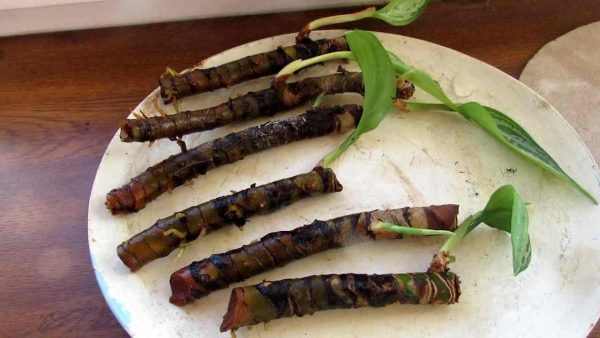
Aglaonema cuttings photo
A positive result of the procedure depends on proper care, compliance with temperature and water conditions. The favorable temperature for rooting cuttings is +22°… +26 °C. Roots form in 2-3 weeks. When propagating in winter, the process of root formation will take 1-1.5 months.
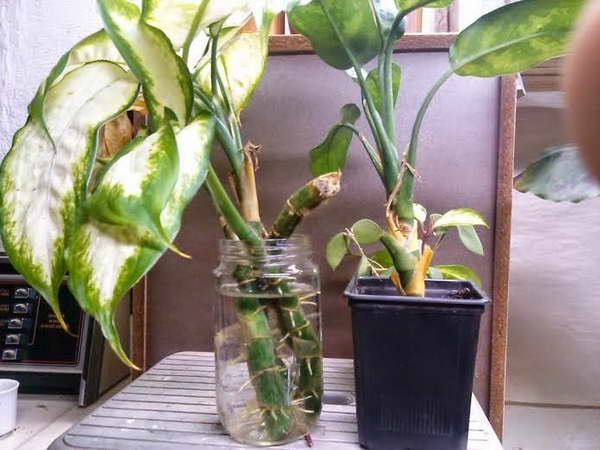
It is possible to root cuttings in water
Aglaonema cuttings can also be rooted in water. Before this, it is necessary to soak them for 24 hours in a root former solution. The biostimulator will not hurt when rooting in the ground.
In the future, the cuttings are cared for in the same way as an adult plant.
3.Reproduction by root and lateral layering
At the time of transplanting an overgrown flower, you can separate the daughter layers from the bush:
- Before replanting, water the soil generously, remove the plant from the pot, and shake the roots off the ground.
- Disassemble the roots and cut off daughter cuttings using a sharp knife. The cut areas are disinfected with charcoal powder.
- Plant the shoots in separate pots.
- Care for layering as usual.
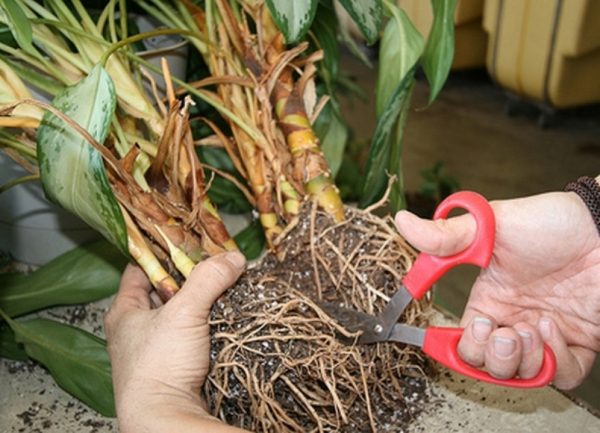
Reproduction of aglaonema by dividing roots photo
Attention! Layers must have a growing point and their own full-fledged roots.
Difficulties in growing aglaonema
If you neglect the minimum requirements for caring for aglaonema, the flower may even die. An attentive florist will always pay attention to signs indicating trouble in the flower.
| Signs of trouble | Cause | Elimination methods |
| The tips of the leaves darken and wrinkle | Dry air | Moistening leaves from a spray bottle, installing a tray with water |
| Leaves become covered with brown spots and curl | A sharp drop in temperature, draft | Eliminating drafts, increasing temperature |
| Pale foliage color | Lack of lighting or feeding | Move the flower to a brighter place, feed |
| Pale yellow spots on foliage | Burn from exposure to direct sunlight | Place the flower in partial shade, wait for the plant to cool, and only then moisten the foliage with soft, settled water. |
| Slow bush growth, brown foliage | Cold and hard water | Water the plants with soft water. To soften water use oxalic or citric acid |
By properly caring for indoor aglaonema, you can avoid all these problems.
Diseases and pests
Indoor flowers especially need care when fighting diseases and pests.
Insects - pests
Aglaonema is most often affected by spider mites, aphids, and mealybugs.
Appearance spider mite causes dry air. Cobwebs appear on the shoots, the leaves wither and fall off.
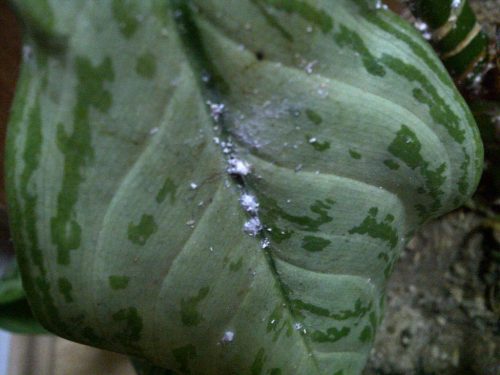
Mealybugs photo
Mealybugs settle on leaves and young shoots. The leaves lose their shape, dry out and fall off.
Aphid lives on the underside of leaf blades, on the tops of shoots. Damaged parts turn pale, leaves become deformed.
Corrective measures. Wipe the leaves and stems with a cloth moistened with soapy water, leave for 15 minutes and rinse with a warm shower. Carry out regular spraying. In case of severe damage, aglaonema can be treated with a solution of Actellik, Inta-Vir.
What can you get sick with?
Aglaonema in apartment conditions are little susceptible to disease, but due to errors in care it can develop gray mold and leaf spot.
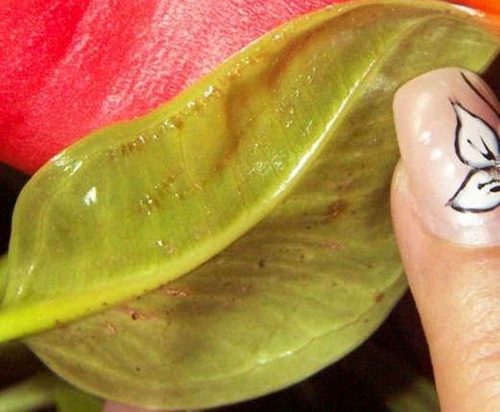
Gray rot
Gray rot appears on the leaves as gray spots, soft to the touch. The reason is low temperature, high humidity and poor ventilation.
Control measures: treatment with Bordeaux mixture, removal of affected leaves.
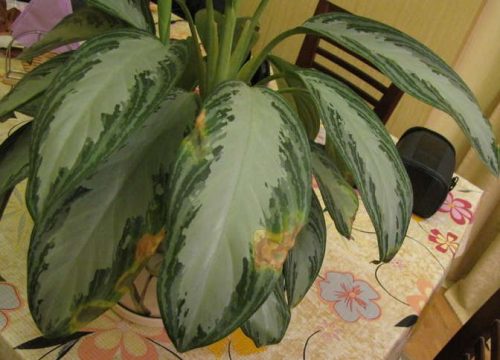
Leaf spot
Leaf spot appears as weeping brown spots on the leaves. The reason is waterlogging, fungal infection.
Control measures: removing affected leaves, treating the plant with a fungicide, reducing watering, stopping spraying.
Is it possible to keep aglaonema at home?
It is difficult to answer the question unambiguously. In room conditions, aglaonema exhibits the following positive properties:
- Purifies the air from toxic impurities such as formaldehyde, benzene (which is found in car exhaust gases or appears when using gas stoves).
- Enriches the atmosphere with air ions.
- Humidifies the air in the room.
- Aglaonema modesta destroys streptococcal infections.
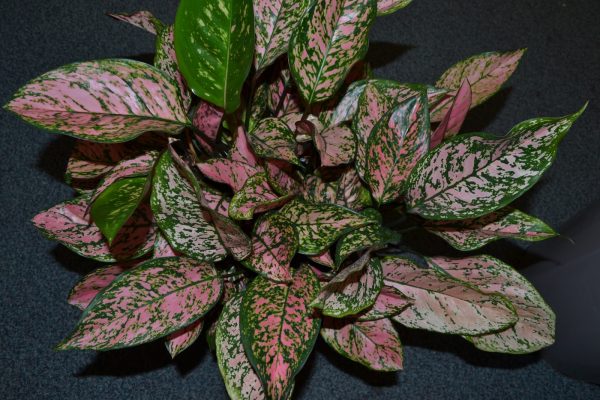
Important! Caring for aglaonema in an apartment should be done with gloves, avoiding contact of the plant juice with the skin of the hands or other parts of the body.
Aglaonema - signs and superstitions
People tend to explain certain life circumstances with signs or superstitions. Flowers are often credited with certain qualities that supposedly influence people. So, aglaonema was endowed with the following qualities:
- Increases a person’s ability to work.
- Relieves tension and irritability.
- Protects against thieves.
- Expels males from the house where he grows up!
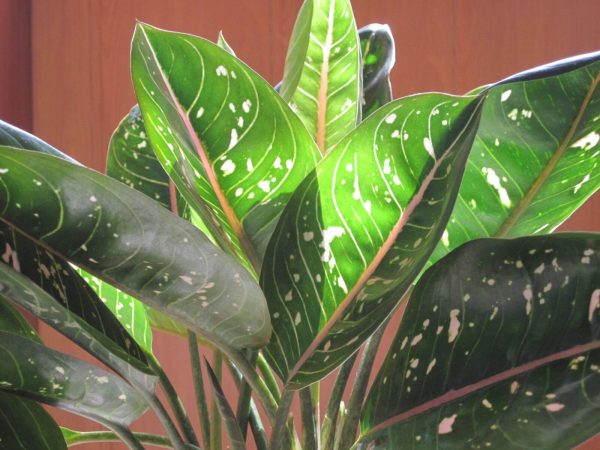
Aglaonema flower photo
If we go on vacation
Unfortunately, aglaonema should not be left without care for a long time, because... it requires constant hydration. When leaving, it is best to entrust your neighbors to take care of the flowers. If this is not possible, it is recommended to water the plant well, place the pot in a tray with expanded clay, which is filled with water, but so that the surface of the expanded clay remains dry. The top layer of soil in the pot should also be sprinkled with wet expanded clay. After this, it is best to place the tray with the pot on the floor.
Conclusion:
Caring for aglaonema as a house flower is not difficult. You just need to remember the basic rules:
- Moderate soil and air humidity.
- Diffused lighting.
- Temperature regime.
The flower will thank you for your love and care with lush foliage with an unusual color.
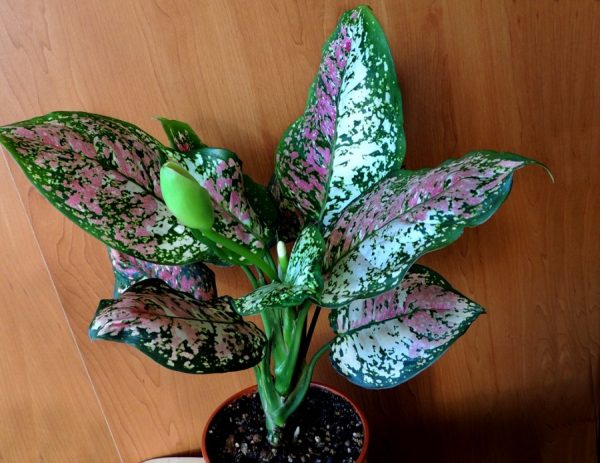
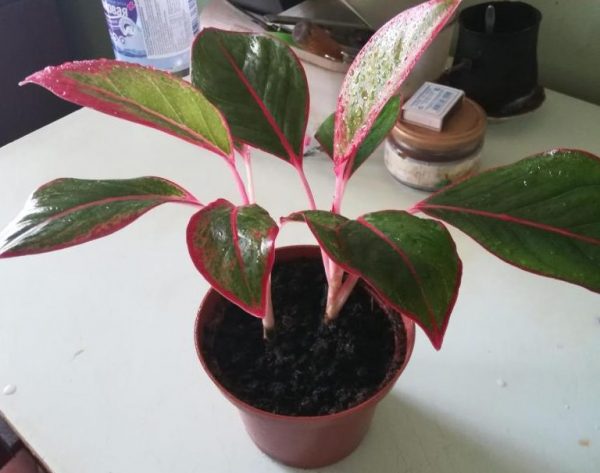
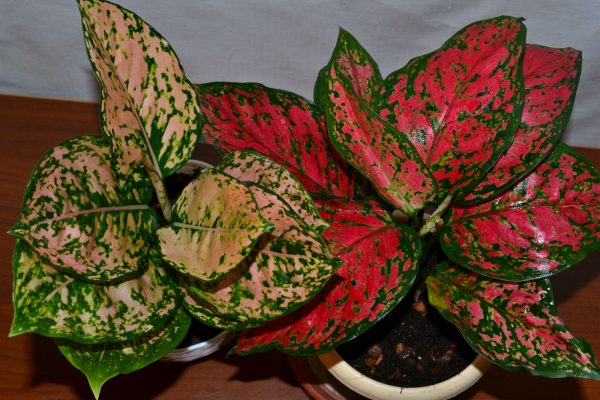
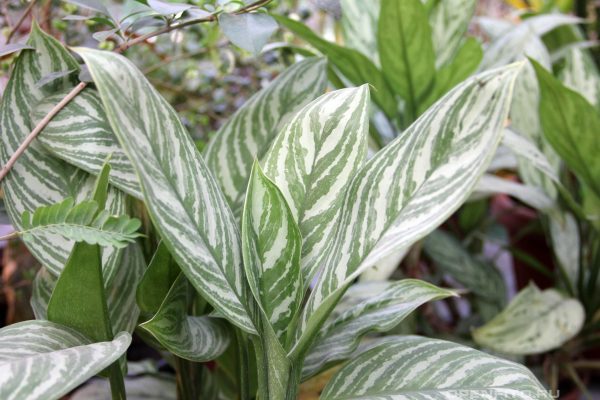
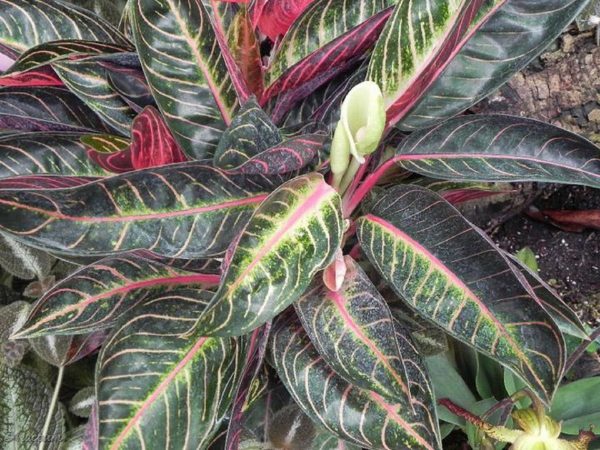
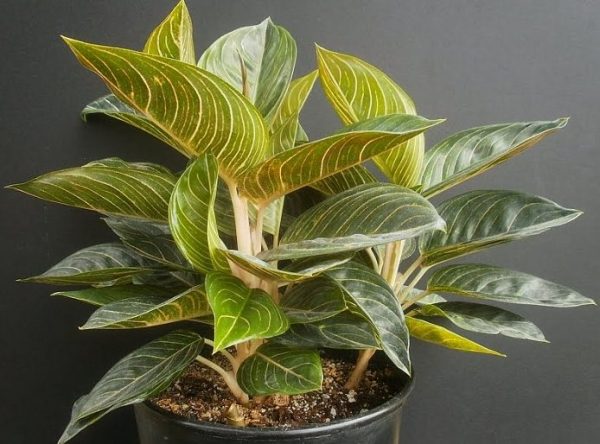

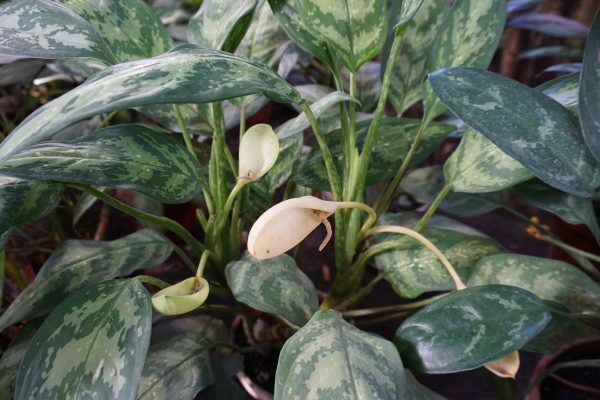
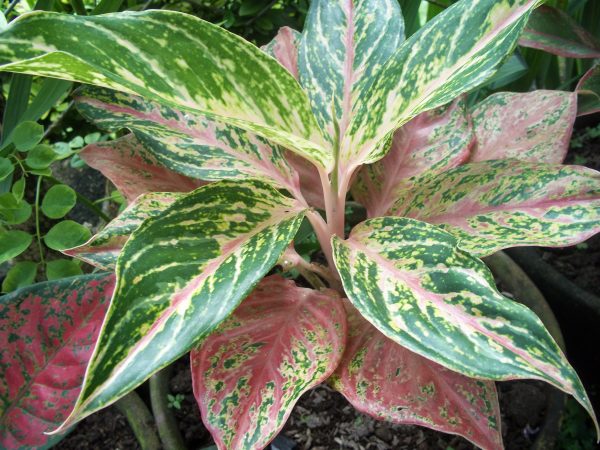
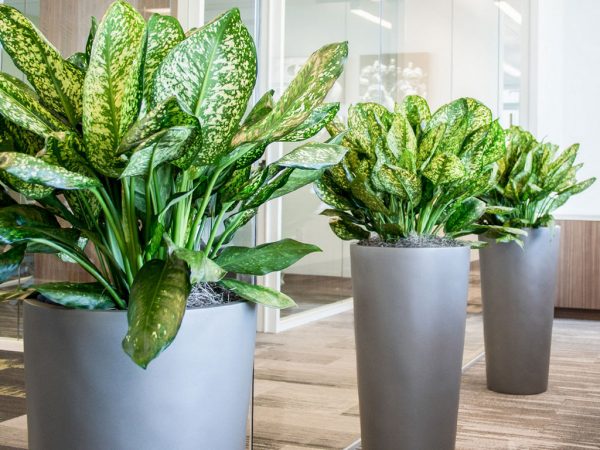
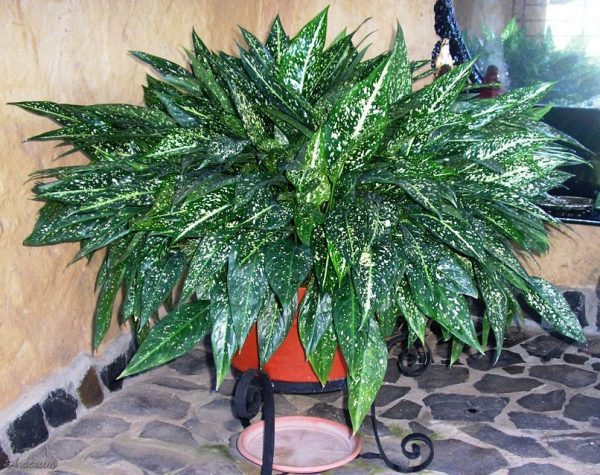
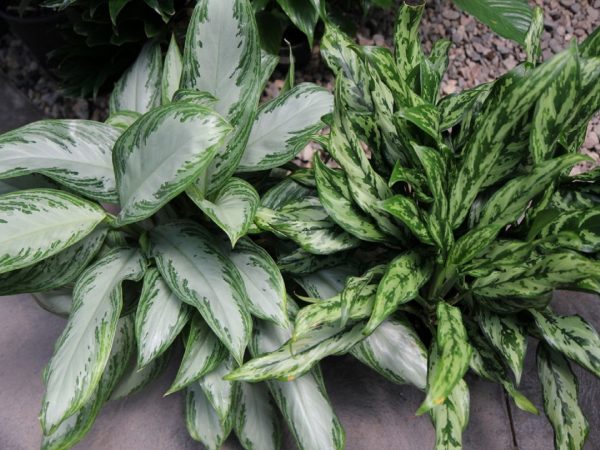
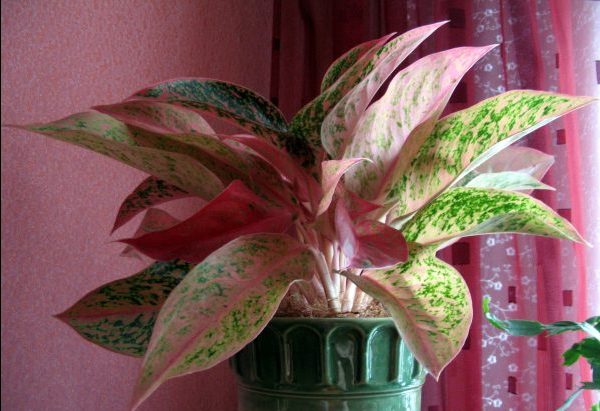

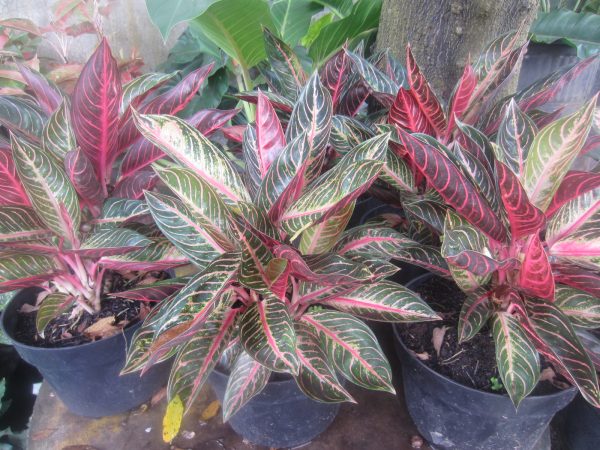



 CUCUMBERS NEVER GET SICK, I'VE BEEN USING ONLY THIS FOR 40 YEARS! I SHARE A SECRET WITH YOU, CUCUMBERS ARE LIKE THE PICTURE!
CUCUMBERS NEVER GET SICK, I'VE BEEN USING ONLY THIS FOR 40 YEARS! I SHARE A SECRET WITH YOU, CUCUMBERS ARE LIKE THE PICTURE! You can dig a bucket of potatoes from each bush. Do you think these are fairy tales? Watch the video
You can dig a bucket of potatoes from each bush. Do you think these are fairy tales? Watch the video
 How our fellow gardeners work in Korea. There is a lot to learn and just fun to watch.
How our fellow gardeners work in Korea. There is a lot to learn and just fun to watch. Eye trainer. The author claims that with daily viewing, vision is restored. They don't charge money for views.
Eye trainer. The author claims that with daily viewing, vision is restored. They don't charge money for views. A 3-ingredient cake recipe in 30 minutes is better than Napoleon. Simple and very tasty.
A 3-ingredient cake recipe in 30 minutes is better than Napoleon. Simple and very tasty. Therapeutic exercises for cervical osteochondrosis. A complete set of exercises.
Therapeutic exercises for cervical osteochondrosis. A complete set of exercises. Which indoor plants match your zodiac sign?
Which indoor plants match your zodiac sign? What about them? Excursion to German dachas.
What about them? Excursion to German dachas.
I really love aglaonemas, but for some reason they don’t grow for me. Already 2 Aglaonem women have disappeared.